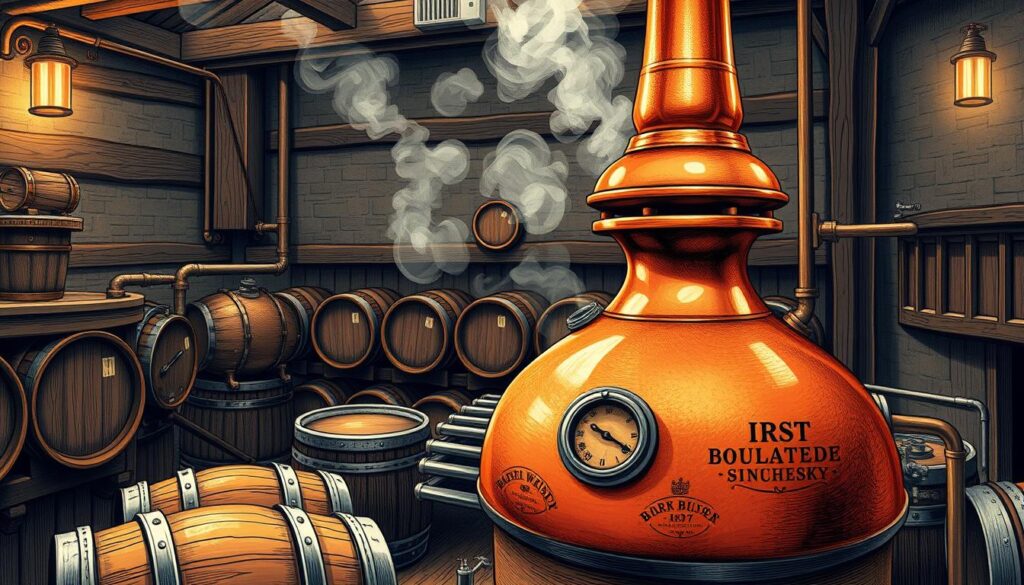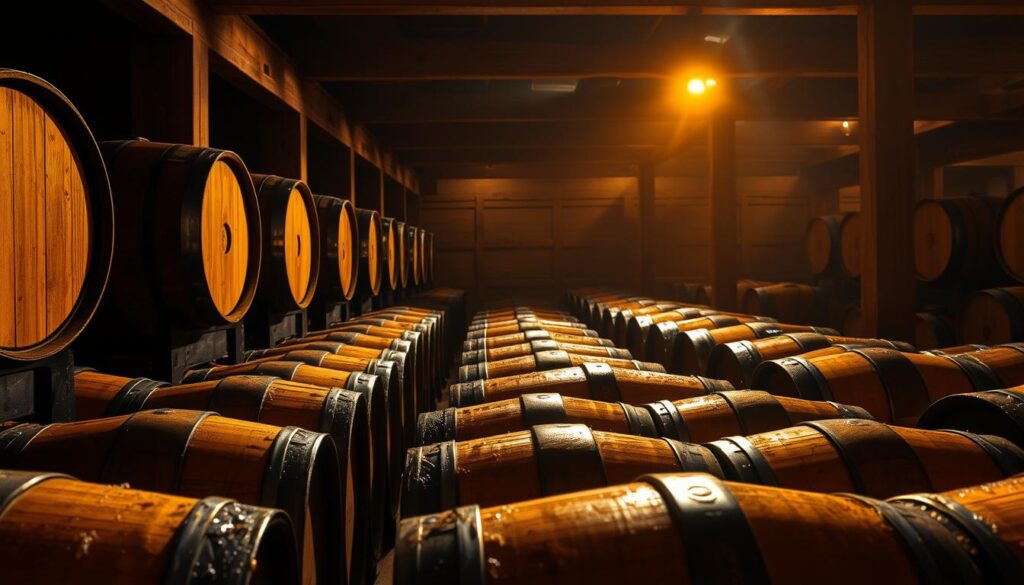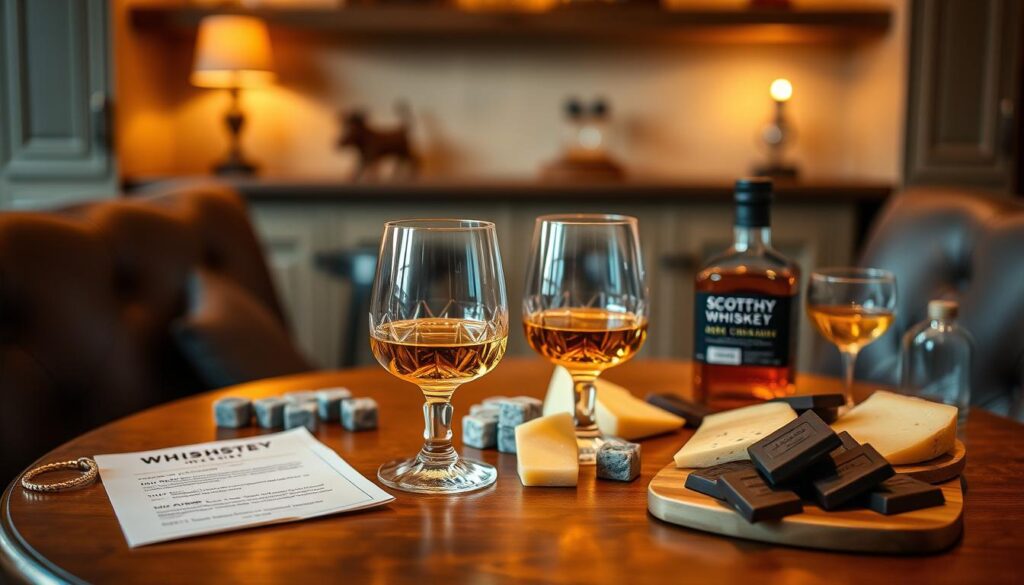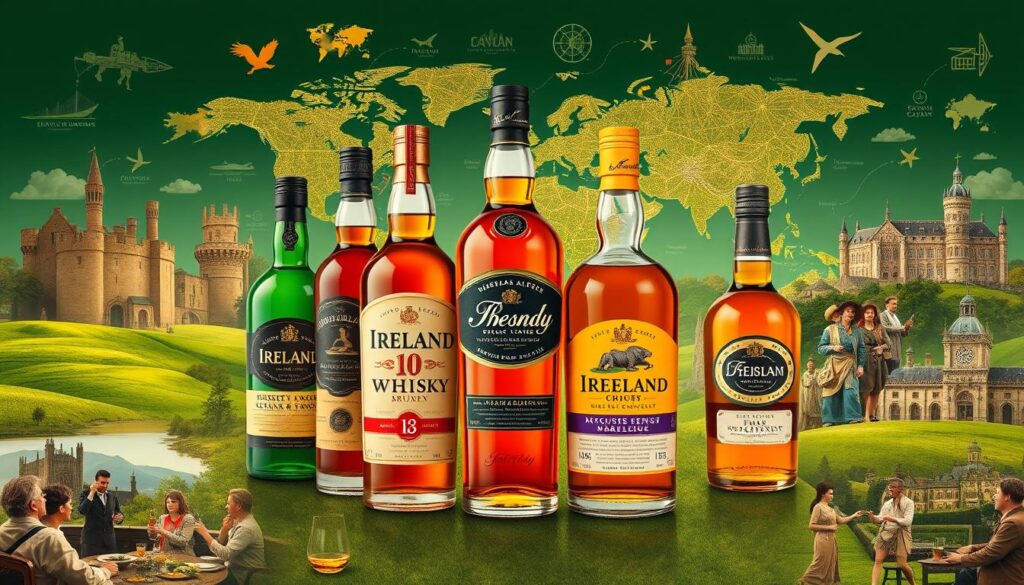Irish Whisky vs Scotch Whiskey: Exploring the Differences The rivalry between Irish whisky and Scotch whiskey has lasted for centuries, with each country boasting a rich heritage and distinct whiskey-making traditions.
From the lush green fields of Ireland to the rugged landscapes of Scotland, these spirits reflect the unique cultures and craftsmanship of their regions. Even the spelling — “whiskey” for Irish and “whisky” for Scots — hints at deeper historical and production differences.
This small yet significant distinction points to deeper historical and production variations that set these iconic drinks apart. Continue reading to discover the key differences in production, taste, and the unique characteristics that make each whisky special.
A Tale of Two Traditions: Historical Origins and Evolution
The story of Irish and Scottish whiskey starts in medieval times. Irish monks brought traditional distillation to both lands. Over the centuries, each region developed its own unique character through craftsmanship.
The oldest recorded Scottish distillation was in 1494. This marked the beginning of a long whiskey-making tradition. Ireland recognized its whiskey history in 1608 with the first distillery license.
The Kilbeggan Distillery, founded in 1757, is Ireland’s oldest still-operating distillery. It shows the lasting spirit of Irish whiskey making. The Irish method of triple distillation created a smooth spirit.
Scottish whisky production grew in the 15th century. Each region, like Highland, Lowland, and Islay, developed its own style. Scottish distillers used peat smoking, giving many Scotch whiskies their smoky taste.
Irish whiskey suffered a severe decline in the 19th century but has since made a strong comeback. Today, people sell it in over 140 countries. Scottish whisky remains a top global spirit. Both countries keep their historical whiskey-making traditions alive, shaping their modern identities.
Irish Whisky vs Scotch Whiskey: Understanding the Basics
Irish and Scotch whiskeys differ significantly in production methods and characteristics. Irish whiskey is typically triple-distilled, resulting in a smoother profile. Meanwhile, Scotch whiskey undergoes double distillation, giving it a richer, more robust character.
Irish whiskey, made exclusively in Ireland, must have a minimum alcohol content of 40%. It comes in two main styles: single pot still, known for its spicy notes, and single malt, appreciated for its smoothness.
Blended Irish whiskey dominates the market, accounting for 90% of production. Notable brands include Jameson and Powers from The New Midleton Distillery. Alongside contributions from Old Bushmills and Cooley Distillery, all of which uphold Ireland’s storied whiskey heritage.
Irish whiskey’s light and versatile nature makes it suitable for various serving styles—neat, with water, or over ice. It pairs especially well with delicate dishes like sushi or smoked salmon. This enhances its appeal as a refined choice for whiskey enthusiasts.

Production Methods and Techniques
Making Irish whiskey and Scotch involves special distillation methods. Irish distillers use a triple distillation process, making their whiskey smoother. Scottish producers, on the other hand, stick to double distillation, which gives their whiskey a stronger flavor.
The choice of grains is key in making malt whiskey. Irish whiskey uses both malted and unmalted barley. Single pot still varieties need at least 30% of each type. Scotch, however, mainly uses malted barley, which adds to its unique taste.
Pot still distillation is a core part of traditional whiskey making in both countries. Copper pot stills are essential in creating complex flavors during heating. These tall copper vessels transform the fermented liquid into spirit through careful temperature control and precise timing.
Both Irish and Scottish distillers follow strict standards. They must keep alcohol levels below 94.8% ABV during production. Irish distillers often use larger pot stills, which affects the spirit’s character and smoothness. These differences in equipment and techniques make each whiskey unique.
The Role of Peat in Whiskey Making
Peat is key in making whiskies with a smoky taste. It’s from ancient organic matter in boglands. This process gives peated whiskey its unique flavor through traditional methods.
Studies show peat’s big impact on whiskey. Comprehensive research highlights how peat turns simple spirits into complex, smoky ones.
Scottish distilleries use peat levels in parts per million (ppm). They range from 1-3 ppm for Highland whiskies to 15 ppm for coastal ones. The way peat is cut and dried has stayed the same for generations.
Each region’s peat makes its whiskey taste different. This makes every spirit unique.
Irish whiskey often uses less peat than Scottish. But, some Irish distilleries make peated whiskey, too. Guides show how Irish whiskey, like Connemara, can also have smoky flavors.
This variety in whiskey making enriches the world of spirits and gives fans many different tastes to enjoy.

Maturation and Aging Processes
The whiskey maturation process creates unique flavors in Irish and Scotch spirits. Both need at least three years in casks. Irish whiskey ages in wooden casks in Ireland, while Scotch matures in Scotland’s varied climates.
Scotland’s different climates, from coastal Islay to Speyside, shape Scotch’s flavors. Ireland’s climate is more steady, leading to smoother tastes.
Both traditions use many cask types for aging. Ex-bourbon barrels are common, adding vanilla and caramel. Distilleries also try rum, sherry, and beer casks for complex tastes. Producers keep casks under 700 liters for the best spirit-to-wood contact.
The wood used greatly affects the whiskey’s taste. Oak is the top choice, with American and European types offering different flavors. American oak brings sweet vanilla, while European oak adds spice.
Types and Classifications
Scotland boasts five primary types of whiskey:
- Single Malt: Made from 100% malted barley at a single distillery, it highlights the craftsmanship of individual distilleries.
- Single Grain: Crafted using grains other than barley, often at specialized distilleries, and used in blends.
- Blended Whiskey: Comprising nearly 90% of Scottish whiskey production, it blends single malts with grain whiskeys for a balanced flavor.
- Blended Malt: A mix of single malts from different distilleries, offering unique flavor combinations.
- Blended Grain: A blend of grain whiskeys from various distilleries, showcasing versatility.
Scottish single malt must be double distilled and aged for a minimum of three years to earn its designation.
Irish whiskey also features diverse styles:
- Single Pot Still: Unique to Ireland, it combines malted and unmalted barley for a spicy, rich flavor.
- Single Malt: Made from 100% malted barley, it undergoes triple distillation for a smooth finish.
- Grain Whiskey: Typically lighter in character, made with grains like corn or wheat.
- Blended Whiskey: Combines different whiskey styles, offering wide-ranging flavors.
Irish whiskey must also age for at least three years, with triple distillation contributing to its smoother profile.
The methods and rules governing production play a significant role in distinguishing these whiskeys. For example, Scotland relies on double distillation, while Ireland uses triple distillation. Each type reflects its region’s history and tradition, providing whiskey enthusiasts with a vast array of flavors to explore.

Flavor Profiles and Characteristics
Whiskey tasting shows big differences between Irish and Scotch spirits. Irish whiskey is light and smooth, with flavors of apples, peaches, and pears. A proper whiskey-tasting session highlights these flavors, making Irish whiskey great for beginners.
Scotch whiskey, on the other hand, is bold and complex. It has a fuller body and deeper taste, thanks to Scotland’s varied whiskey-making regions. Each area adds its own unique flavors, from Islay’s sea notes to Speyside’s honey.
Irish whiskey often has vanilla and a gentle warmth, making it easy to drink. Scotch, however, has stronger flavors, like sweet honey and oak, with some having smoky notes.

Modern Market Dynamics and Global Recognition
The whiskey market is growing fast, expected to hit USD 101.23 billion by 2031. People now prefer premium spirits, valuing quality over quantity. In the U.S., Irish whiskey sales have jumped 92% in ten years, reaching 4.7 million cases in 2023.
Global brands are changing to meet new tastes. Jameson’s success is a prime example, growing from 0.5 million cases in 1988 to 10.4 million in 2022. New players are entering the market, bringing new ideas to whiskey-making.
Now, the industry is all about trying new things with grain profiles. Waterford Distillery focuses on barley, while others mix different grains. There’s also a rise in whiskey tourism and online sales. Premium craft spirits are attracting more women, especially through cocktails and ready-to-drink options.
Whiskey is becoming a smart investment, with cask returns of over 10% a year. North America is the biggest market, with 40% of Irish whiskey sales. Governments are supporting this growth, seeing whiskey as a key economic player.
Final Thoughts: The Lasting Impact of Irish and Scotch Whisky
The comparison between Irish whiskey and Scotch whisky reveals a tale of two proud traditions. Irish whiskey’s triple distillation delivers a smooth, approachable spirit, while Scotch’s double distillation offers bold, smoky flavors. Both rely on oak aging and meticulous craftsmanship to produce world-class spirits.
Whether you prefer the light and versatile Irish whiskey or the complex and robust Scotch, both offer something special. These timeless spirits continue to evolve, reflecting the rich heritage and innovation of their makers.
The debate doesn’t end here! Dive deeper into the nuances of these iconic spirits and uncover what makes each truly unique at Scotland Whiskey. From the smooth triple distillation of Irish whisky to the bold, smoky flavors of Scotch, there’s always more to explore.
Discover related topics on our blog:
- The key differences between single malt and blended Scotch whisky.
- A guide to the best Scotch whiskies for beginners.
- How Irish whisky’s history and heritage shaped its unique profile.
Visit us today to expand your whisky expertise and find your perfect dram.